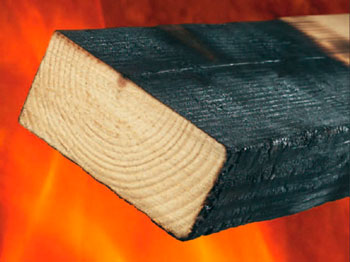What is Fire Retardant Wood Treated With: Ultimate Protection Revealed
When it comes to building and construction, ensuring the safety and resilience of structures is of utmost importance. One crucial aspect of this is fire safety, and one method used to enhance the fire resistance of wood is through treatment with fire retardants. In this article, we’ll delve into what fire retardant wood is treated with and how it works to protect the wood from fire damage.
What are Fire Retardants?
Fire retardants are substances that are applied to materials, including wood, to reduce their flammability and delay the spread of fire. They can be classified into several types based on their mode of action, including physical action, chemical action, or a combination of both. When it comes to wood, fire retardants work by either forming a protective char layer on the wood’s surface or by inhibiting the chemical reactions that occur during combustion.

Credit: www.fp-supply.com
Common Fire Retardants for Wood
There are several chemicals that are commonly used as fire retardants for wood treatment. These include:
| Chemical | Mode of Action |
|---|---|
| Ammonium Phosphate | Chemical action – acts as a heat sink and releases water vapor to dilute flammable gases. |
| Ammonium Sulfate | Chemical action – releases water vapor and ammonia gas to dilute flammable gases. |
| Borates | Chemical action – disrupts the combustion process by releasing water and carbon dioxide and forming a protective char layer. |
| Phosphate-based Compounds | Chemical action – release water vapor and phosphoric acid, diluting flammable gases and forming a protective char layer. |
How Fire Retardant Wood Treatment Works
When wood is treated with fire retardants, the chemicals penetrate the wood and become an integral part of its structure. In the event of a fire, these chemicals are activated and work to prevent or slow down the combustion process. For example, substances like borates release water vapor and carbon dioxide when exposed to heat, effectively diluting the flammable gases and forming a protective layer of char that insulates the wood and slows down the spread of flames.
Benefits of Fire Retardant Wood
Using fire retardant treated wood in construction and building projects offers several advantages:
- Improved fire safety: The primary benefit is the enhanced fire resistance of structures, reducing the risk of fire damage.
- Compliance with building codes: Many building codes and regulations require the use of fire retardant materials in certain applications.
- Longevity: Fire retardant treatment can extend the lifespan of wood by protecting it from fire and decay.
- Versatility: Treated wood can be used in a variety of indoor and outdoor applications, expanding its usability.
- Peace of mind: Using fire retardant wood provides peace of mind for occupants and property owners, knowing that the structures are better protected against fire hazards.
Frequently Asked Questions On What Is Fire Retardant Wood Treated With: Ultimate Protection Revealed
What Is Fire Retardant Wood Treatment?
Fire retardant wood treatment is a process of applying chemicals to wood to reduce its flammability and slow down the spread of fire.
How Does Fire Retardant Wood Work?
Fire retardant wood works by reducing the rate at which flames can spread across the wood’s surface, making it more difficult for a fire to ignite and sustain itself.
Is Fire Retardant Wood Treatment Safe?
Yes, fire retardant wood treatment is safe when used according to manufacturer’s instructions and regulatory guidelines. It undergoes rigorous testing to ensure safety.
What Are The Benefits Of Using Fire Retardant Wood?
Using fire retardant wood can help protect buildings and structures from fire, comply with safety regulations, and potentially reduce insurance costs.
Conclusion
Fire retardant wood treated with specific chemicals plays a crucial role in enhancing the fire resistance of wood-based materials, contributing to improved safety and protection in buildings and construction projects. Understanding the types of fire retardants and how they work is essential for choosing the right materials and ensuring compliance with fire safety standards.






